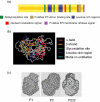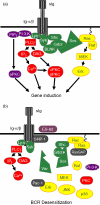Signalling mechanisms underlying subversion of the immune response by the filarial nematode secreted product ES-62
- PMID: 15946247
- PMCID: PMC1782160
- DOI: 10.1111/j.1365-2567.2005.02167.x
Signalling mechanisms underlying subversion of the immune response by the filarial nematode secreted product ES-62
Abstract
Secretion of immunomodulatory molecules is a key strategy employed by pathogens to enable their survival in host organisms. For example, arthropod-transmitted filarial nematodes, which achieve longevity within the infected host by suppressing and modulating the host immune response, produce excretory-secretory (ES) products that have been demonstrated to possess immunomodulatory properties. In this review we discuss the immunomodulatory effects of the phosphorylcholine-containing filarial nematode-secreted glycoprotein ES-62 and describe the intracellular signal transduction pathways it targets to achieve these effects.
Figures




Similar articles
-
Subversion of immune cell signal transduction pathways by the secreted filarial nematode product, ES-62.Parasitology. 2005;130 Suppl:S63-8. doi: 10.1017/S0031182005008164. Parasitology. 2005. PMID: 16281993 Review.
-
Subversion of immunological signalling by a filarial nematode phosphorylcholine-containing secreted product.Cell Signal. 2005 Jan;17(1):11-6. doi: 10.1016/j.cellsig.2004.05.014. Cell Signal. 2005. PMID: 15451020 Review.
-
Antigen receptor signaling is subverted by an immunomodulatory product secreted by a filarial nematode.Arch Immunol Ther Exp (Warsz). 2001;49(4):263-9. Arch Immunol Ther Exp (Warsz). 2001. PMID: 11726028 Review.
-
Modulation of the host immune system by phosphorylcholine-containing glycoproteins secreted by parasitic filarial nematodes.Biochim Biophys Acta. 2001 May 28;1539(1-2):7-15. doi: 10.1016/s0167-4889(01)00101-x. Biochim Biophys Acta. 2001. PMID: 11389964 Review.
-
Investigation of strategies with potential for producing a phosphorylcholine-free version of the filarial nematode immunomodulator, ES-62.J Helminthol. 2006 Sep;80(3):261-5. J Helminthol. 2006. PMID: 16923269
Cited by
-
The therapeutic potential of the filarial nematode-derived immunodulator, ES-62 in inflammatory disease.Clin Exp Immunol. 2010 Mar;159(3):256-67. doi: 10.1111/j.1365-2249.2009.04064.x. Epub 2009 Dec 1. Clin Exp Immunol. 2010. PMID: 19968663 Free PMC article.
-
Proteomic analysis of plasma exosomes from Cystic Echinococcosis patients provides in vivo support for distinct immune response profiles in active vs inactive infection and suggests potential biomarkers.PLoS Negl Trop Dis. 2020 Oct 5;14(10):e0008586. doi: 10.1371/journal.pntd.0008586. eCollection 2020 Oct. PLoS Negl Trop Dis. 2020. PMID: 33017416 Free PMC article.
-
Detection and site localization of phosphorylcholine-modified peptides by NanoLC-ESI-MS/MS using precursor ion scanning and multiple reaction monitoring experiments.J Am Soc Mass Spectrom. 2015 Mar;26(3):460-71. doi: 10.1007/s13361-014-1036-3. Epub 2014 Dec 9. J Am Soc Mass Spectrom. 2015. PMID: 25487775
-
Genome-wide identification of molecular mimicry candidates in parasites.PLoS One. 2011 Mar 8;6(3):e17546. doi: 10.1371/journal.pone.0017546. PLoS One. 2011. PMID: 21408160 Free PMC article.
-
DC-SIGN signalling induced by Trichinella spiralis products contributes to the tolerogenic signatures of human dendritic cells.Sci Rep. 2020 Nov 20;10(1):20283. doi: 10.1038/s41598-020-77497-x. Sci Rep. 2020. PMID: 33219293 Free PMC article.
References
-
- WHO. Filariasis. Geneva: World Health Organisation; 2000.
-
- Subramanian S, Stolk WA, Ramaiah KD, et al. The dynamics of Wuchereria bancrofti infection: a model-based analysis of longitudinal data from Pondicherry. India Parasitol. 2004;128:467–82. 10.1017/S0031182004004822. - DOI - PubMed
-
- King CL. Transmission intensity and human immune responses to lymphatic filariasis. Parasite Immunol. 2001;23:363–71. 10.1046/j.1365-3024.2001.00395.x. - DOI - PubMed
-
- Brattig NW. Pathogenesis and host responses in human onchocerciasis. Impact of Onchocerca filariae and Wolbachia endobacteria. Microbes Infect. 2004;6:113–28. - PubMed
-
- Maizels RM, Blaxter ML, Scott AL. Immunological genomics of Brugia malayi: filarial genes implicated in immune evasion and protective immunity. Parasite Immunol. 2001;23:327–44. 10.1046/j.1365-3024.2001.00397.x. - DOI - PubMed
Publication types
MeSH terms
Substances
Grants and funding
LinkOut - more resources
Full Text Sources

